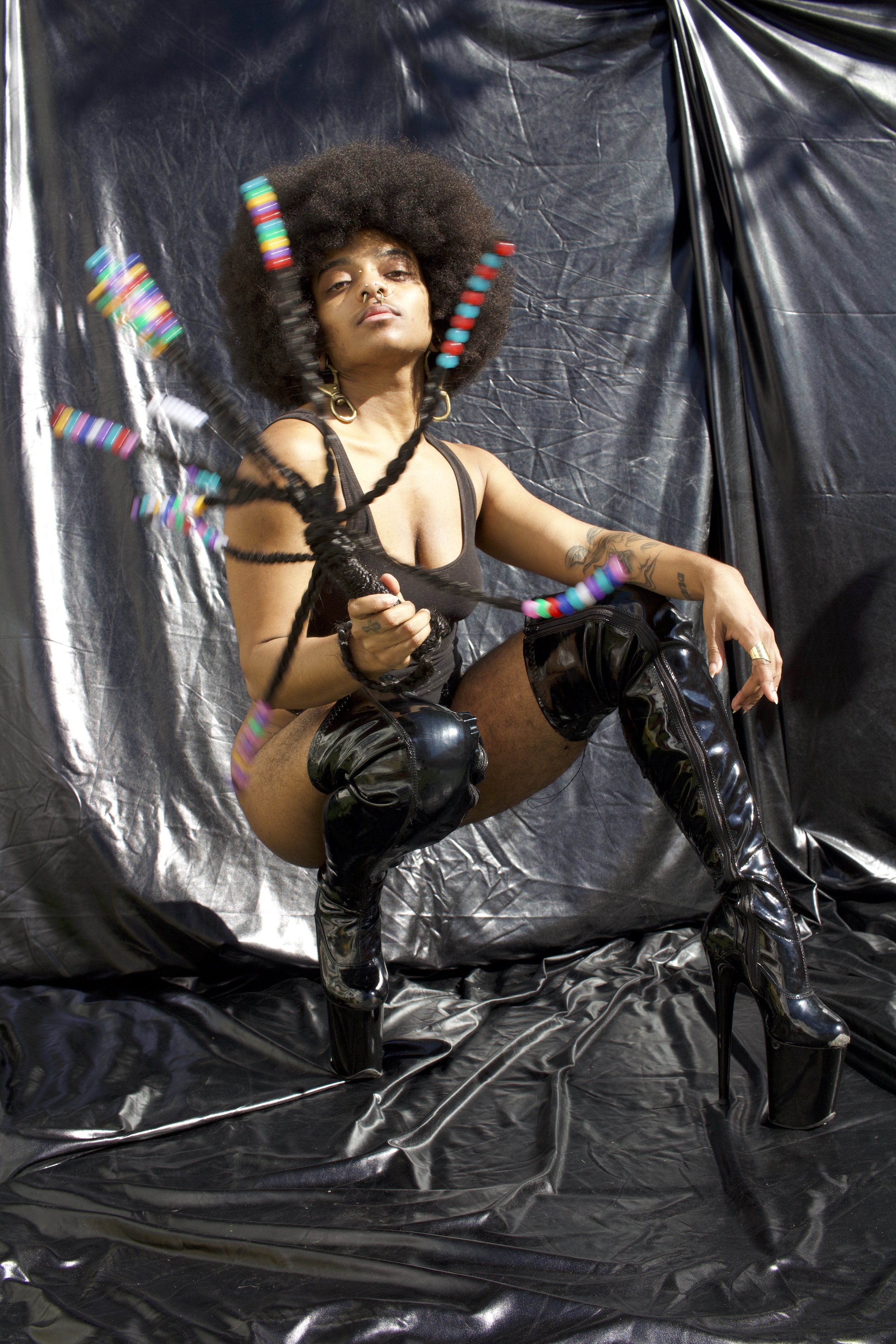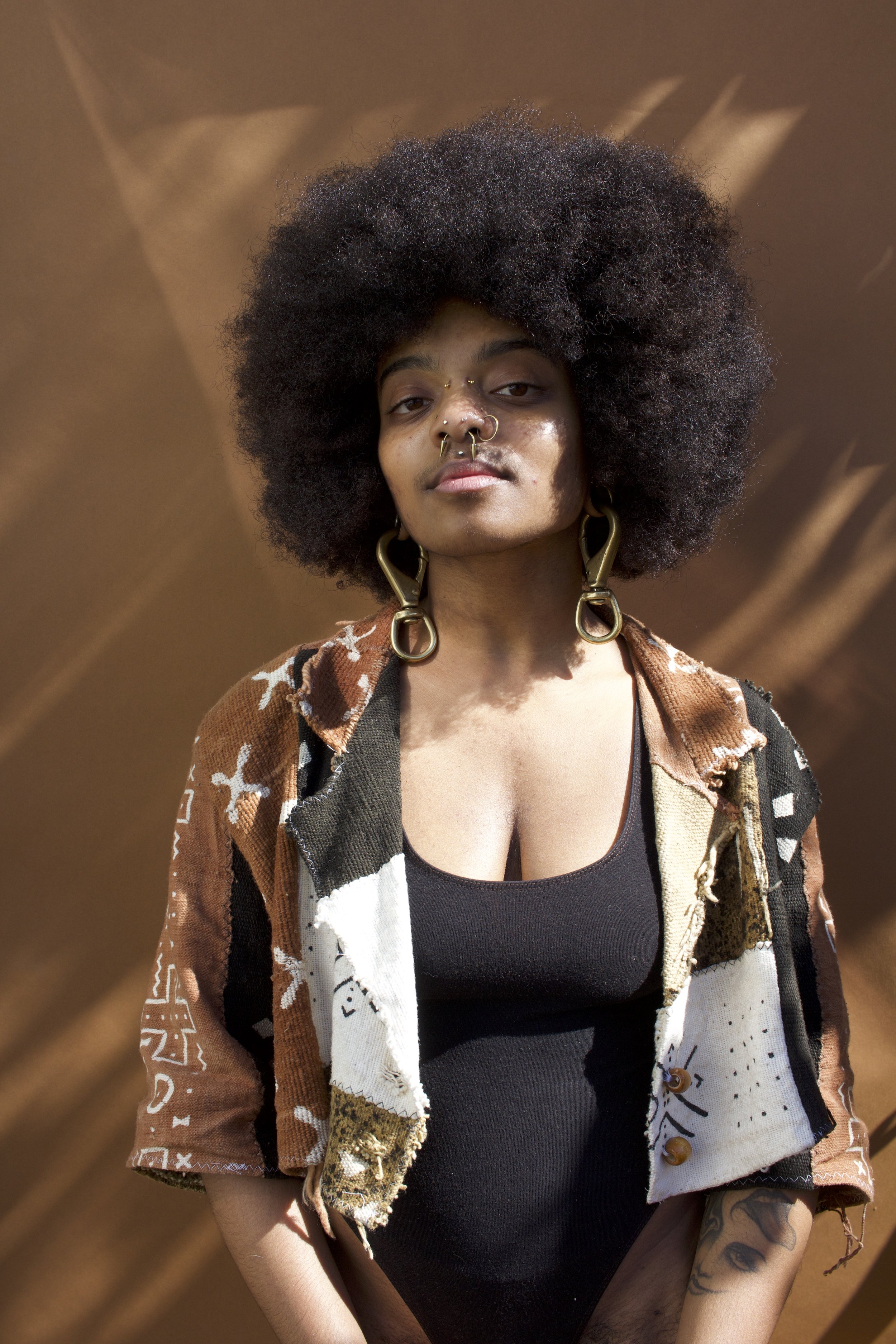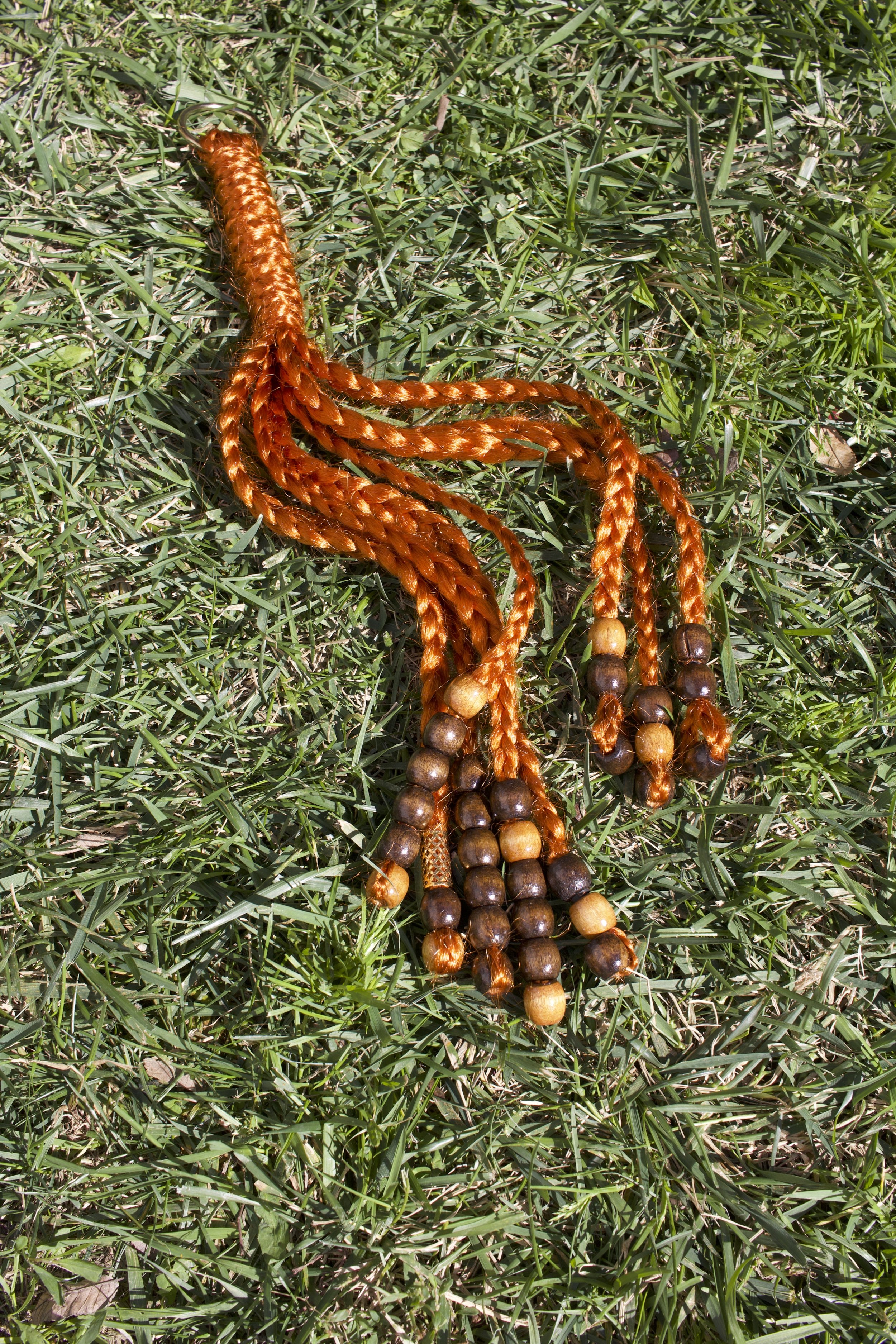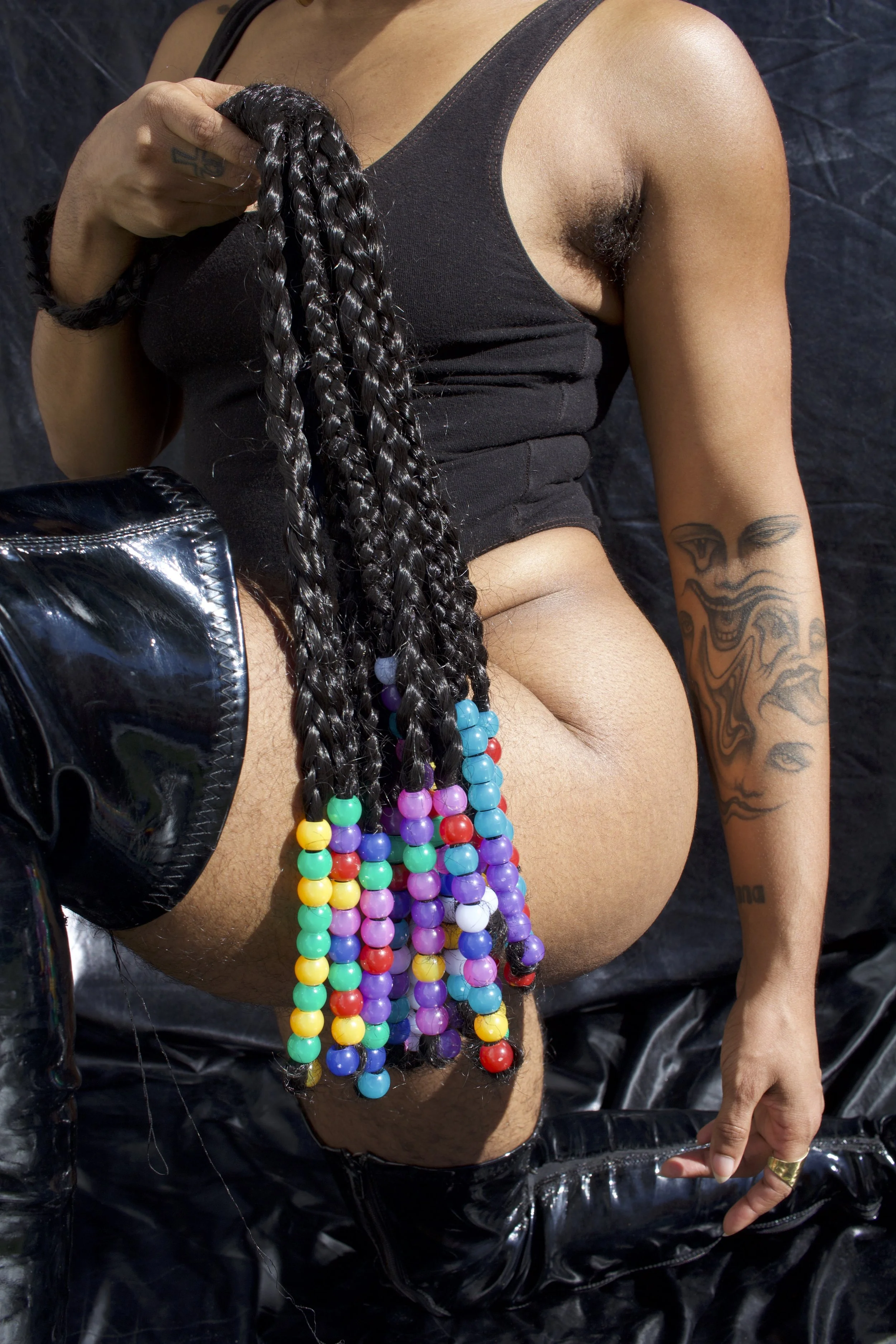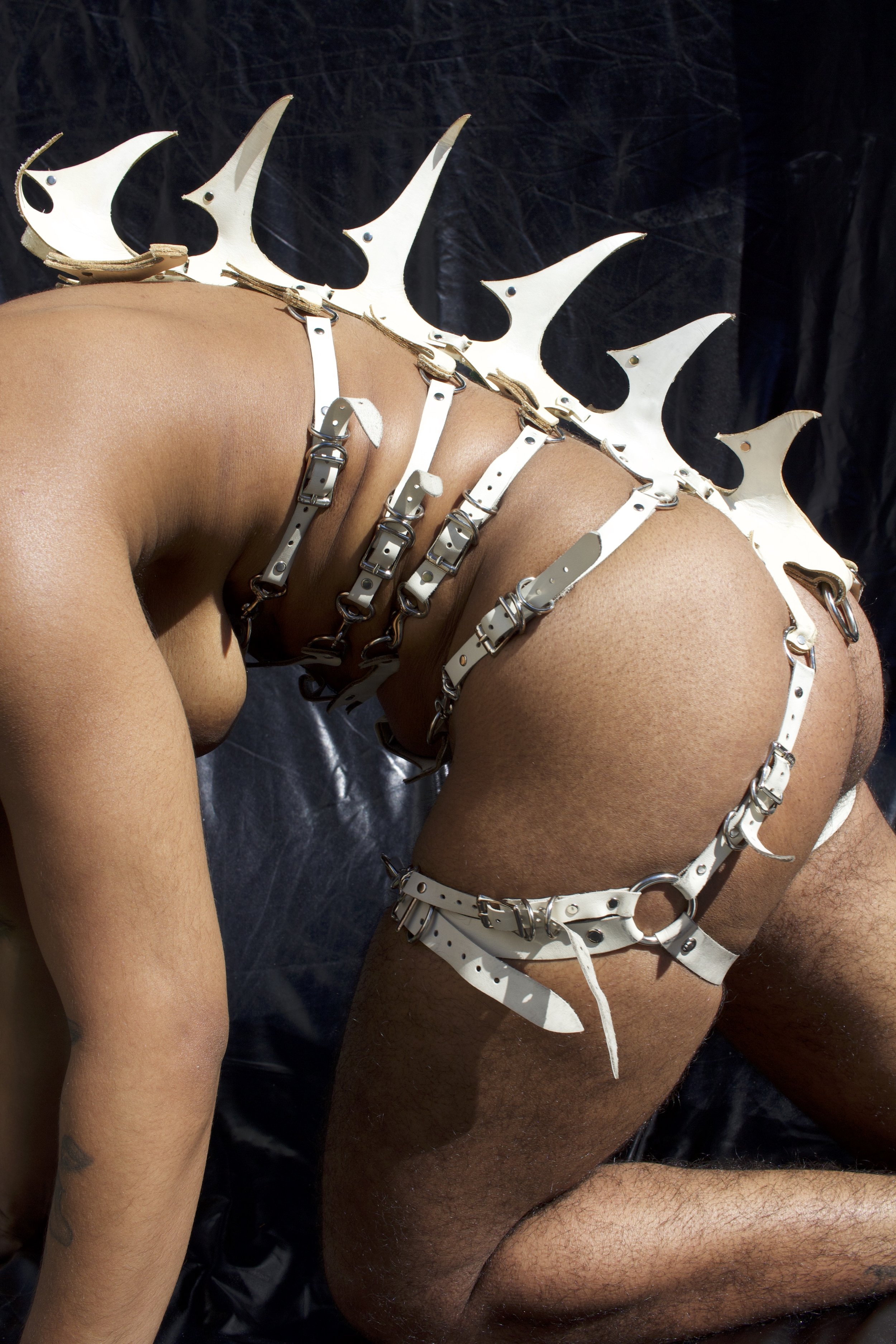Black Butterfly
WRITTEN and photographed BY Salima allen
Anansi and Salima sit cross legged in the sunny grass after days of intense rain. They sip on butterfly pea flower tea across from each other.
Salima: How did you get connected to the Level Ground residency?
Anansi: I had some friends that gently nudged me to apply. This was the first residency I applied for. I was feeling really insecure and was struggling with imposter syndrome, but upon doing more research, I realized I knew and recognized a lot of people that were coming in and out of Level Ground, and that gave me a feeling of home. I had been in a rut with art making for years and this opportunity was a reminder that we can bloom more than once. The sense of community and expansiveness attracted me to this residency. Level Ground has been so incredible with supporting me as, not just an artist, but as an individual.
“When I first started exploring kink and BDSM, I was in middle school about to go into high school. I was really excited, but I simultaneously felt this unease, and I didn’t really know why until I unearthed it. ”
S: Can you tell me a little bit about your upcoming solo exhibition?
A: My show specifically surrounds the liberatory potential of kink/ BDSM for Black bodies and anyone who identifies within the African diaspora. I believe kink and BDSM to be root work. Within the community there's a lot to say about consent, making choices, feeling autonomous, aftercare, having and taking designated time to tend to yourself…but also having other people tend to you, which is not something that we all are granted, in our day to day.
When I first started exploring kink and BDSM, I was in middle school about to go into high school. I was really excited, but I simultaneously felt this unease, and I didn't really know why until I unearthed it. I felt this immense amount of guilt and discomfort. I was like, “how could I be into being suspended from rope in a tree? How can I be into intense impact play and hook suspension? Why does cracking a whip intrigue me so?...”. The historical implications are very real, and I think with my show there's a focus on impact play, rope bondage, and the connection that Black beings have with nature, restoring that, and replacing imagery that can be triggering with something very beautiful.
Being in the kink and BDSM scene, there are so many opportunities to remove Black subjugation. There's a lot to say about prioritizing rest and stillness. When I think about rope bondage, right? feeling your body, all of your body being the center of your attention, the center of someone else's attention, trusting someone. When you are in a scene with someone that you've been building a relationship with, it's really beautiful to be able to find spaces for surrendering and letting your body go and feeling the weight of your body just hanging in all of the pain, joy, and processing of it all.
"I used to struggle with exploring the different creatures and monsters I am because of the bestialization and thingification of Blackness."
〰️
"I used to struggle with exploring the different creatures and monsters I am because of the bestialization and thingification of Blackness." 〰️
S: What are some ways that you subvert the idea of forced performance or spectacle in a world that is constantly othering Blackness?
A: The word spectacle comes up in a lot of my research, my ritual, my performance, and specifically the show. Taking rope bondage and considering lynching imagery; that was an entertainment space for white people. They would gather around Black bodies [our death], it would be like a festival. My work responds to “who is this for?” and “what's the perspective of the lens?” I was very careful to make sure that my work was for us.
With my video piece, I considered doing the rope bondage scene in a public place, but by doing it with the trees in a secluded space, we could enjoy it, we could process it, move through death, and move through life. We can unearth and trace what it means for us to experience safety and autonomy. I think that also goes for my own specific performance, as a shapeshifter. I used to struggle with exploring the different creatures and monsters I am because of the bestialization and thingification of Blackness. I have to be able to use all of myself in performance and remove the white gaze from my process. To be ourselves, be whatever animal, creature, human, whatever… I think it's really important and allows for more play.
S: In your syllabus, you referenced feeling past shame regarding BDSM and you mentioned that you overcame that by grounding your work in nature. Can you expand on how nature has come into play in your practice?
“I’ve always felt more grounded in nature. I feel like we’re [Black people] carried by these invisible bodies and I shout out our ancestors all the time. I believe our ancestors are the trees and being able to sit with them and talk to them is something that’s really special. ”
A: I've always felt more grounded in nature. I feel like we're [Black people] carried by these invisible bodies and I shout out our ancestors all the time. I believe our ancestors are the trees and being able to sit with them and talk to them is something that's really special. A lot of our connection to nature has been severed. It's hard to tap back in when it feels as though there's no time for stopping within capitalism. I think it's important for us to pause and listen. Taking my practice to nature is how I move through and heal ancestral trauma.
S: Could speak a little more to the importance of checking in with yourself and others in this fast-paced world, and the importance of consent and its power to reclaim autonomy and sexuality?
A: There's a lot that you can hold in your body from saying yes to everything. It took a really long time for the word “no” to find a home in my mouth. And specifically for Black people within the context of American slavery and BDSM, it wasn't that long ago when we weren't able to say no to just about anything.
There are a lot of people that either don't know how or feel they don’t have the time to check in with themselves. Grind culture is destructive. I used to disregard what my body was communicating with me, but bodies can break, and spirits can grow heavy. It's just too much.
Being able to stand firm in your decisions and advocate for yourself, advocate for your body is so important. It makes loving and being loved so much easier when you're able to say what you need, and what you want, and what you don't want, and what you might want.
S: How does unlocking your body's range inspire you?
A: When I was younger, I used to dance in the dark. It made me feel limitless, like I wasn't bound by this meat suit that we're all in. It took me a long time to just accept that I was in a body. It felt like there were so many limitations, but being able to learn how to bend and shift and move the energy within myself and extend it outward helped me connect with myself and better identify where I might still be hurting emotionally, even if I wasn't sure why. It allows me to be a more open and fluid person for myself and for others.
S: Your work really speaks to the importance of experimentation, discovery, and play. When do you feel most joyful, and what tools do you use to overcome any fear that arises?
A: I feel the most joy when I'm laughing so hard that I'm crying and then I'm snorting and I just feel silly and a little dumb, and let the nonsense wash over me which is not something I get to do often. I also feel joy in stillness.
When fears like imposter syndrome and self doubt arise, naming it is really helpful because I realize that I just want to be proud of myself. I conceptualized the video I made for my show years ago and never made it. I've had it all laid out, the concept, how I wanted it to feel, the shots I wanted to capture… and I just didn't do it. And finally I was like, why? I had so many seeds of ideas. I was a seed keeper, but I never planted them. And I was like wait, what's the point of having them if I'm not going to plant them, watch them grow, and tend to them?
"I had so many seeds of ideas. I was a seed keeper, but I never planted them."
〰️
"I had so many seeds of ideas. I was a seed keeper, but I never planted them." 〰️
S: On the topic of nurturing, what have been some of the most rewarding aspects of belonging in a Black Queer Kink community?
A: One of the most rewarding parts for me is talking about our shared experiences. For the longest time my kink exploration was all solo, and it felt like it needed to be because it took me a while to find other Black kinky queers and at the time exploring with non Black people didn’t make me feel safe. Most BDSM spaces are white centric and cisheteronormative. The lack of visibility for anyone who identifies outside of that is uncomfortable. I think about the beautiful conversation I had with my crew after our video shoot. During a rope suspension scene, we all witnessed this potent imagery of a Black body tied in rope and suspended from a tree. We were all so grateful that we could watch the sub go up and come back down safely. Afterwards we talked about what that meant for all of us, and it was really powerful, heavy, healing, and beautiful.
S: Can you speak to the importance of texture in your work? It is evident from the very beginning of your process, your sketchbook is filled with objects sewn and taped inside.
A: That definitely comes from my family. I grew up with my mom, my grandmother, and my sister. It was a very powerful femme environment. There was a lot of weaving, whether it be crocheting, knitting, or embroidering. My grandmother and my mom taught us how beautiful our hands were, how powerful our hands were, and how much information we can absorb through them. I'm a very sensitive being and I think that sometimes I need to touch things to understand them. I think about when I go to art shows, how I just wanna touch the work so badly, or rub it on my face. But I can't do that, so there is this disconnect sometimes from what I'm witnessing. There's just so much sensory memory in experience. When recalling BDSM work, specifically rope bondage, I think of the marks made, there's a little mapping of what was just experienced, where the rope was, and how tightly it was coiled around the body.
S: Yeah. It feels like a form of tangible archiving.
A: Absolutely, 'cause it's all about experiencing it fully, and saving it to memory. That includes experiencing it through our bodies.
Salima is a multimedia artist based out of LA whose photography practice focuses on meaningful connections and bold colors. She is the co-founder of inclusive photo studio Acid Smile Studios, where she and her co collaborator uplift the compelling causes of those they work with.

